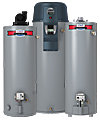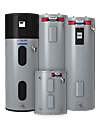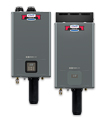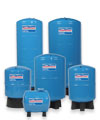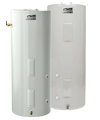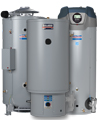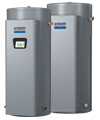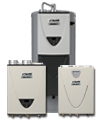Adapt™ SC Standard Condensing
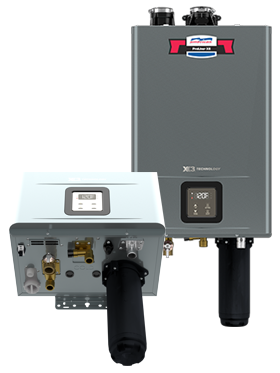 American’s ADAPT™ SC standard condensing tankless water heaters are available in 160k, 180k and 199k BTU/Hr. These natural gas units deliver a max flow rate of 10.5 GPM, as well as robust, on-demand performance and the flexibility to install in virtually any residential setting.
American’s ADAPT™ SC standard condensing tankless water heaters are available in 160k, 180k and 199k BTU/Hr. These natural gas units deliver a max flow rate of 10.5 GPM, as well as robust, on-demand performance and the flexibility to install in virtually any residential setting.
There are two design options available including models with integrated X3® Scale Prevention Technology, and Bypass (M) models. Easily add scale prevention protection to any M model by replacing the bypass cartridge with an optional X3 cartridge sold separately. Optional X3® Scale Prevention Technology helps maintain like-new performance by protecting the heat exchanger from buildup. X3 Scale Prevention Technology helps protect the heat exchanger resulting in up to three times longer life than a standard tankless water heater while maintaining like-new performance.
The ADAPT™ SC line features a built-in control display for setting and checking heater status and error codes. All models are ENERGY STAR® certified with a Uniform Energy Factor of 0.95 and comply with Ultra-Low NOx regulations.
All ADAPT™ SC models can be installed indoors or outdoors (outdoor vent cap kit sold separately). Cascade up to 12 like heaters for larger applications requiring multiple water heaters to work in conjunction, cable included.
Download a Product Sales Sheet
Download a Product Specification Sheet
Learn More With American University
How Adapt™ SC Standard Condensing Works
 Adapt™ SC, standard condensing tankless water heaters by American offer an efficient solution for continuous hot water supply. Unlike traditional tank systems, it heats water on demand, ensuring you have hot water whenever needed without the energy losses associated with storing heated water.
Adapt™ SC, standard condensing tankless water heaters by American offer an efficient solution for continuous hot water supply. Unlike traditional tank systems, it heats water on demand, ensuring you have hot water whenever needed without the energy losses associated with storing heated water.
When the hot water tap is activated, cold water enters the unit, triggering the system to ignite its gas burner. This burner heats the water as it flows through the primary heat exchanger. Then water passes through a secondary heat exchanger, which captures residual heat from the exhaust gases. This dual-exchanger process enhances energy efficiency, achieving a Uniform Energy Factor (UEF) of 0.95, meaning 95% of the energy consumed is effectively converted into hot water.
The Adapt™ SC models are designed for flexibility, allowing installation in various settings, either indoors or outdoors, with an optional vent cap kit. They support PVC venting up to 150 feet, accommodating diverse installation requirements. Additionally, for homes with higher hot water demands, up to 12 units can be linked together, ensuring a consistent and ample hot water supply.
These units feature a built-in control display, enabling users to monitor system status, adjust settings, and view error codes easily. Certain models feature integrated X3® Scale Prevention Technology while the feature can be added as an optional accessory for Bypass (M) models. Patented, the X3 technology provides protection against scale buildup and extends the lifespan of the heat exchanger.
Features and Benefits
Application and Installation
Still Have Questions?
Is a gas tankless water heater better than a tank?
A gas tankless water heater is more efficient than a conventional tank water heater, as it doesn't require energy to keep a reservoir of water heated around the clock. Water flows to a heat exchanger that immediately heats the water using hot exhaust gasses. According to the U.S. Department of Energy, a tankless water heater is up to 34% more energy efficient than a tank water heater for homes using less than 41 gallons of water per day and up to 14% more efficient for homes using 86 gallons of water daily. It's also more compact than a tank water heater, saving space.
How do you vent a condensing tankless water heater?
Tankless water heaters offer the option of venting through an exterior side wall instead of through a chimney flue on the roof. Water heaters that are direct venting have two vents — one that pulls in air from the outside and one that carries away exhaust. Power venting water heaters draw air from inside the room and have only a single vent for exhaust. While non-condensing tankless water heaters require thick metal venting to handle the temperature of heat that's released, condensing tankless water heaters can use plastic venting such as PVC. They have already used the hot vapors to heat more water, leaving only cooler fumes for ventilation.
How long does a condensing tankless water heater last?
American tankless water heaters boast industry-leading 15 year limited warranties. While the lifespan of a gas tankless water heater can vary, factors like water conditions, usage rates and maintenance all contribute to your water heater’s health. New condensing units come equipped with X3® Scale Prevention Technology that extends life up to three times longer.
How do I determine which Adapt™ gas tankless water heater I need?
Tankless water heaters have different flow rates measured in gallons per minute (GPM), which indicate the amount of water they can deliver at a time. Because these water heaters don't maintain a supply of hot water in a tank, you need to choose an appropriately sized tankless model based on household needs. The ideal output rate for your home depends on the number of people in the residence, the appliances you use, and the original temperature of the water being heated. Some people install more than one tankless water heater based on their requirements. Check out our water heater selector to help choose the best water heater for your needs.
What should I consider before installing a gas tankless water heater?
• What do I need?
Before installation, you will need to determine the incoming ground water temperature, the ideal location in your home, and the correct water heater size required for your needs.
• Where to install?
A tankless water heater can be installed anywhere in your home with the correct piping—closets, garage, bathrooms, etc. In warmer climates where there is no risk of freezing, a tankless water heater may be installed on the exterior of the home to save on interior space.
